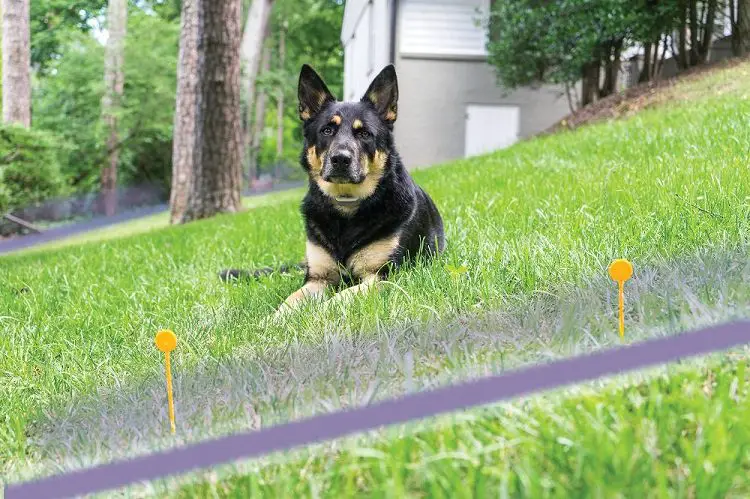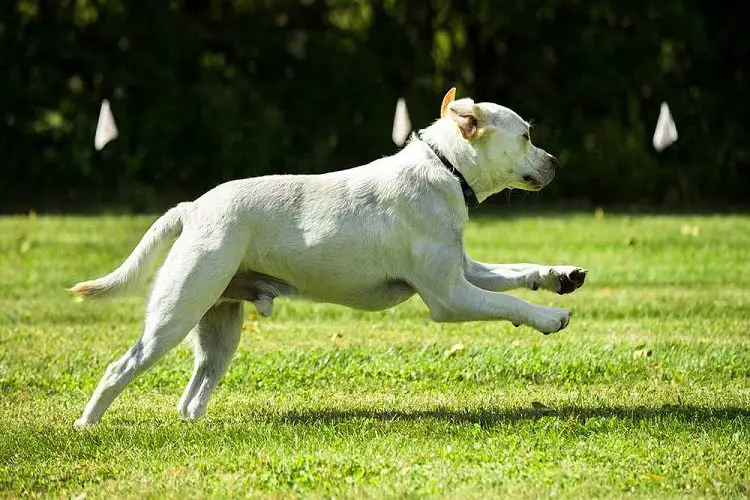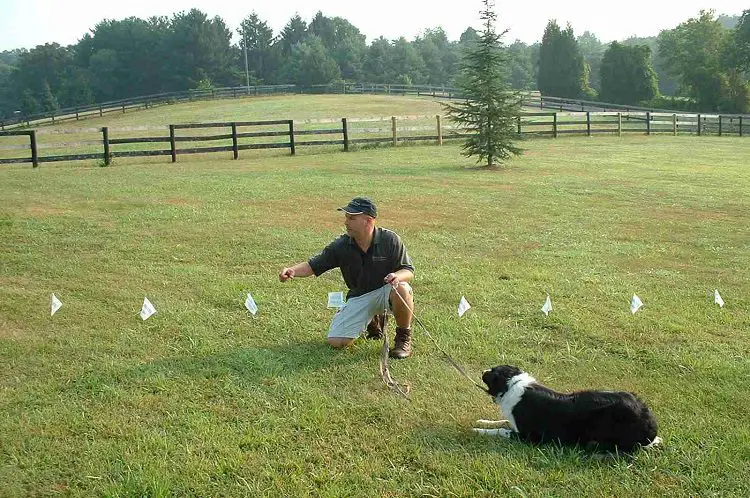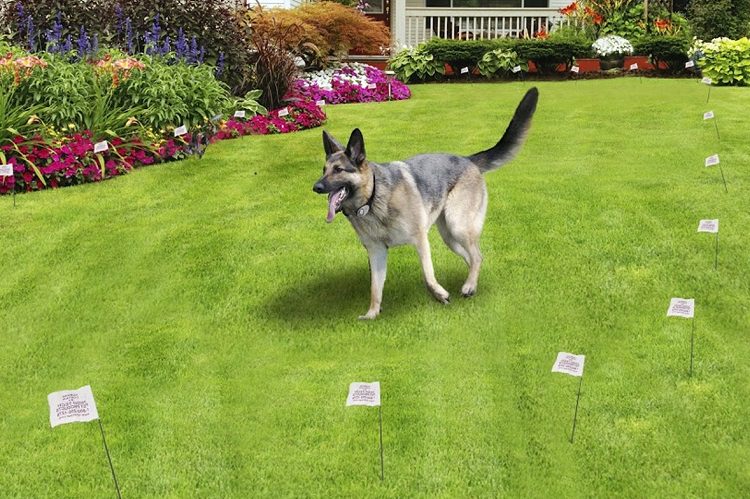Last Updated: 3 years ago
We love our dogs, there’s no doubt about that.
They go everywhere with us, they have a way of knowing how to cheer us up, and it’s no wonder why they are called, “Man’s Best Friend.” For all the love in the world that we shower these pups with, they still seem to want to make a run for it the second the door opens!
With an invisible dog fence installed on your property, Fido can run outside all he wants, but you can breathe easily in knowing that he isn’t going to get into harm’s way.
What Is An Invisible Dog Fence?
Most homeowners who have a dog will have some kind of fencing around their property so that their dog can go outside, run around, and play without worrying about running away, running into traffic, or attacking neighbors who may be passing by.
The problem with traditional fencing is that it can get pretty costly to have installed.
Depending on the type of fence and the size of your yard, you could be looking at a price tag of anywhere from $17 per linear foot up to $36 per linear foot, which could get up to $8,000 if not more!
A more affordable option is an invisible dog fence, as they can run anywhere from $150 up to $1,500 for the premium grade fence. There are a few different types of dog fences you could choose from:
In-Ground / Wired
People will choose this type of invisible fencing if they aren’t traveling and they are concerned that their dogs will chase cars or people in the neighborhood.
This system requires that you bury the electric dog fence wire under the ground. When your dog approaches the perimeter, the special collar your dog will wear is going to give them a warning when they get too close (or goes over) the fence.
How Does An In-Ground / Wired Fence Work?
The collar your dog wears with an in-ground wired fence is going to activate whenever it picks up a signal from the buried boundary wire. You can lay the boundary wire however you need to, over any type of landscape and obstruction you may encounter.
Wireless
A wireless fence is often preferred by people who travel with their pets.
A wireless unit will be plugged into the wall and you can adjust the distance to which your dog can roam. Should your dog go outside of the designated zone, the collar will give them a static shock that will correct them.
How Does A Wireless Fence Work?
Unlike the collar of a wired fence, your dog’s collar is going to activate the static correction when it loses the signal from the transmitter. Typically, you will want to put the transmitter in a direct line of sight for your dog. The signals from these transmitters can sometimes get interrupted by metal objects like an aluminum shed.
Which Is The Better Option: Wired Or Wireless?

Both types of electric dog fences have their own merits, so there’s no clear winner.
It all depends on what you’re looking for. Both fences are an effective method of keeping your dog in the yard and both fences are much more affordable than installing a traditional fence.
Yet, there are some significant differences that you may want to think about before deciding which option is best for you.
Your Property Landscape And Size
Typically speaking, a wireless transmitter is only going to be able to cover about 25 acres of property. An in-ground fence is going to be much more powerful and can cover well over 100 acres. You will also want to think about the landscape of your property because it will affect the way your fence functions.
With an in-ground fence, you can lay the wire wherever you need to. With a wireless fence, you have to make sure there are no obstructions so that there is always a clear signal going to the collar from the transmitter.
Shape Of The Area Needed To Be Covered
A wireless fence only has a circular shaped boundary.
This often prevents people from buying a wireless fence because they have an oddly shaped yard, or they do not want to limit the roaming area of their pet. With an in-ground/wired fence, you have complete control of where your dog can go and customize the area to your liking.
Ease Of Installation
One of the biggest draws of a wireless fence is how easy it is to set up – you just plug it in and put the collar on.
An in-ground/wired fence is going to require digging up the trench where the wire will go, which can take an entire afternoon if you’re doing it yourself.
Maintenance Requirements
With a wireless fence, you only have to worry about the transmitter and the collar. With an in-ground/wired fence, you have to worry about the transmitter, the collar, and all that wiring.
Signal Reliability
The main purpose of the electric dog fence is to keep your dog safe, and you can’t do that if you have a weak signal.
Wireless fences tend to be sketchy in that department and sometimes have inconsistent signal strengths – much like your cell phone or WiFi.
How Effective Is An Invisible Dog Fence?

In terms of effectiveness, the only way these tools are going to be effective is by training your dog. You have to train your dog to stay within a given area, usually marked by flags. With the proper training, you can rely on your fence to keep your dog inside the area.
This training period usually takes a couple of weeks from the time you install the fence.
We recommend spending at least 10 to 15 minutes each day to help your dog understand how the fence works. Also, whenever you let your dog outside, you have to make sure they are wearing the collar.
Benefits Of Using An Invisible Dog Fence
People often wonder what are the benefits of using an electric dog fence. Here are some of the benefits of installing an electric dog fence.
Affordability
As we’ve previously mentioned, one of these fences is going to be much more affordable than a traditional fence.
Some neighborhoods have guidelines as to what type of fencing you can have, which only drives up the cost.
Adaptability
A traditional fence usually only looks good when the landscape is flat. An invisible fence can be used on any terrain and even watery spots.
You can even lay a wired fence in specific patterns for an exercise area, or you can use it to create areas where your dog cannot go, like near the pool, your flower beds, near the driveway, and so forth.
Aesthetics
The beauty of an invisible fence is that it is invisible. You can enjoy the scenery without a traditional fence obscuring the scenery.
You don’t have to worry about whipping out the weed whacker to trim around the fencing – you can just mow right over it.
You don’t have to worry about gates being left open either. In the beginning, you will need to use flags so your dog knows where it can and cannot go, but as they complete their training and respect the boundaries, you can remove the flags.
Convenience
An electric dog fence is going to be much quicker to install than a traditional fence. Even if you purchase an in-ground / wired fence, you can finish the installation process in a day, whereas traditional fences can take a whole weekend or more.
Decreased Human Error
Sometimes people forget to close the gate and the dog can escape. The electric fence will eliminate human error, especially if you get a lot of people coming and going to your home.
Reliability
When a dog wants to get out of a fence, it will do whatever it can to do that. They’ll jump over the fence, climb it, dig under it, or chew their way through.
With an invisible fence, they won’t be able to do that. The only way they’ll be able to escape the invisible fence is if the collar falls off, the battery is dead, or there is something that disrupts the signal.
Protection
While you may not have a “Beware of Dog” sign hanging on a traditional fence, people with ill intentions may see the dog lose in the yard and not attempt to do any harm.
Drawbacks Of An Invisible Dog Fence

While there are plenty of reasons to get an invisible fence, there are some drawbacks that you’ll want to consider before deciding one of these fences are right for you:
Training Is Required
In order for the fence to work for your dog, you have to train them to respect the invisible boundary.
This could take a few days up to a few weeks, depending on how vigilant you are with the training and how receptive the dog is.
You want to walk along the perimeter of the yard and point out the flags that mark the boundary. Most fence companies will include training guides to help you with this.
No Protection
While having your dog out in the yard could deter people from coming in your yard, that isn’t going to stop animals from entering the yard and provoking or hurting your pet.
Barrier Frustration
Sometimes dogs will get agitated when they see neighbors and other animals roaming around freely while they aren’t able to.
This is something you will want to seriously consider, especially if you have a friendly dog who goes up to everyone to say hi, because if they try to with this fence, they will get punished.
Discomfort And Pain
The truth behind these fences is that they can cause some pain and discomfort. While these fences will have an audible warning before the static correction activates, some dogs will ignore the beep and will get shocked.
Some collars will have adjustable static correction levels, and if the collar is on the wrong level, it could cause serious pain.
Reliability
Just as these fences can be a reliable way to keep the dog in the yard, they can also be unreliable if there is a problem with the battery in the collar, the power supply to the transmitter, or if the wire (with a wired fence) has been damaged.
Possibility Of Escape
If your dog has been taunted or sees something they really want to go after, no fence is going to stop them.
Then once they break through the invisible barrier, they’ll be “locked” out because when they realize they aren’t in the yard, the collar will create that static correction, thus telling the dog not to go any closer.
How To Install An Invisible Dog Fence
People get intimidated by the thought of installing an electric dog fence, but the truth is, installing an in-ground wired fence isn’t difficult at all! Here are some useful tips that will show you just how easy it can be!
Use a piece of paper and draw a map of your yard. You’ll want to draw the areas where you do want your dog to go, and the areas where you do not your dog to go.
Next, you’ll want to check the spot where you want to put the transmitter. You don’t want to put the transmitter near anything that could give off a strong signal.
It’s recommended that you keep it at least three feet from refrigerators, water heaters, and the like. Also, make sure you use the hardware that is included with the system for the best results.
Once the unit has been hung, you’ll want to twist the fence wire into the transmitter. If you’ve done this correctly, a light will turn on to indicate it is connected to a circuit.
Using a garden tool like a shovel or a lawn edger, you’ll want to create a trench that is about three inches deep. You’ll then lay the wire in the trench and cover it with dirt.
Use the boundary flags that are included with your system and place them along the path where you laid the wire in intervals of ten feet. You can remove these flags once your dog learns the boundaries.
Put the batteries in the collar and turn the device on. You don’t want to put it on your dog yet.
Read the manufacturer’s instructions to make sure you’ve correctly set the boundary controls. Adjust the distance of the boundary in accordance to the size of your property.
Test the collar by walking along the path to making sure it works. You will want to hold the collar at the same height as if it were around your dog’s neck.
Listen for the collar to beep or vibrate as you get close to the wire. If the collar doesn’t respond as designated on the boundary control dial, you will want to adjust the dial until you have it to the desired setting.
Remove the battery from the collar and put the collar on your dog’s neck.
The metal piece should be centered under your pup’s neck and sit close to the neck. The collar should fit securely, but not so tight that you cannot put your finger between the contact points of the collar and the dog’s neck.
For the training process, you will want to follow the training guide that comes with the system to achieve the best results. Again, it may take some time, but with diligence, your dog will eventually pick up on where it can and cannot go.
Maintaining Your Invisible Fence
If you opt for a wireless dog fence, the only maintenance you really have to be concerned about is making sure the batteries are fully charged, the transmitter is in good repair, and the collar can pick up the signal.
With an in-ground/wired dog fence, may have an instance where you have to repair a broken line. The underground wire can get broken if animals chew through the wire, but you can fix it pretty easily.
To find the break, you’ll want to go along the boundary line with the collar and try to find the dead spot. Once you’ve located the dead spot, dig up the wire. You’ll want to use a splice kit to repair the wire. To make the repair, you will want to:
Tie one end of an extra bit of wire to one side of the broken wire. You want to make sure the knot is tight enough so that any tension on the wire isn’t going to cause the splice to come apart. The ends of the wire may be uneven, so you will want to cut them so they are even.
Strip the ends of your cables so that there is about half of an inch of copper wire showing on each side of the wire break.
Twist two of the copper ends together and place an orange wire nut over the twisted ends. You’ll want to twist the nut until it is nice and snug.
Take the blue gel capsule from the splice kit and open it. Push the wire nut into it until there isn’t any copper wire showing. This is going to prevent moisture, rain, snow, and other elemental factors from damaging the wire further.
You’ll then want to spread the wires to either side of your capsule and then close the capsule tightly around the wires.
Now that one end has been repaired, you will want to repeat this process to the other side of the broken wire.
You want to check the system on a regular basis to ensure everything is in working order. You will also want to make sure the battery in your dog’s collar is still working, too.
Conclusion

Having a dog is one of the many things in life that makes life worth living.
For many of us, our dogs are a member of the family, so it makes perfect sense that you’d want to give them everything within your power to make sure they are healthy and happy. One way to do that is by giving them ample space to run around and play outside.
Instead of keeping your dog on a leash or tethered to a stake, an invisible dog fence is an option many homeowners opt for.
These invisible fences are an affordable containment system that will keep your dog in your yard, without needing to spend several thousands of dollars on a traditional fence.
With one of these invisible fences, it is important to understand that it will take some time to acclimate your dog to the new system.
The training that goes along with these fences will take some time for your dog to catch on, but by taking your dog around along the boundary line (indicated by the flags you install along the underground wire), your dog should be able to catch on within a week or two.
Should you choose an in-ground/wired fence, you have more flexibility in where your dog can go. You’ll have the ability to customize the area where your dog can go. With a wireless system, your dog is limited in where it can go, as these devices have a circular boundary perimeter.
However, a wireless unit may be preferred if you travel a lot with your dog and want your dog to be able to roam in a certain area without needing a leash.
Resources:



